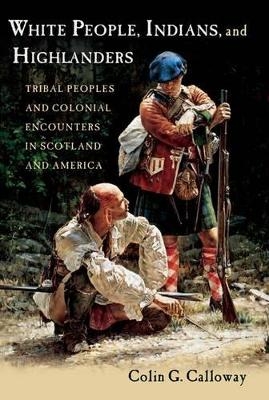
White People, Indians, and Highlanders
Oxford University Press Inc (Verlag)
978-0-19-973782-6 (ISBN)
In nineteenth century paintings, the proud Indian warrior and the Scottish Highland chief appear in similar ways--colorful and wild, righteous and warlike, the last of their kind. Earlier accounts depict both as barbarians, lacking in culture and in need of civilization. By the nineteenth century, intermarriage and cultural contact between the two--described during the Seven Years' War as cousins--was such that Cree, Mohawk, Cherokee, and Salish were often spoken with Gaelic accents.
In this imaginative work of imperial and tribal history, Colin Calloway examines why these two seemingly wildly disparate groups appear to have so much in common.
Both Highland clans and Native American societies underwent parallel experiences on the peripheries of Britain's empire, and often encountered one another on the frontier. Indeed, Highlanders and American Indians fought, traded, and lived together. Both groups were treated as tribal peoples--remnants of a barbaric past--and eventually forced from their ancestral lands as their traditional food sources--cattle in the Highlands and bison on the Great Plains--were decimated to make way for livestock farming. In a familiar pattern, the cultures that conquered them would later romanticize the very ways of life they had destroyed.
White People, Indians, and Highlanders illustrates how these groups alternately resisted and accommodated the cultural and economic assault of colonialism, before their eventual dispossession during the Highland Clearances and Indian Removals. What emerges is a finely-drawn portrait of how indigenous peoples with their own rich identities experienced cultural change, economic transformation, and demographic dislocation amidst the growing power of the British and American empires.
John Kimball Jr. 1943 Professor of History and Professor of Native American Studies, Dartmouth College. Author of The Scratch of a Pen: 1763 and the Transformation of North America (OUP, 2006); One Vast Winter Count: The Native American West Before Lewis and Clark (University of Nebraska Press, 2003; winner of six 'best book' awards); First Peoples: A Documentary Survey of American Indian History (Bedford/St. Martins, 1999, 2004); New Worlds for All: Indians, Europeans, and the Remaking of Early America (Johns Hopkins University Press, 1997); The American Revolution in Indian Country (Cambridge University Press, 1995); The Western Abenakis in Vermont (University of Oklahoma Press, 1990); The Abenaki (Chelsea House, 1989); and Crown and Calumet: British-Indian Relations, 1783-1815 (University of Oklahoma Press, 1997).
PREFACE; INTRODUCTION; EPILOGUE: HISTORY, HERITAGE, AND IDENTITY
| Erscheint lt. Verlag | 15.4.2010 |
|---|---|
| Verlagsort | New York |
| Sprache | englisch |
| Maße | 229 x 152 mm |
| Gewicht | 572 g |
| Themenwelt | Geschichte ► Allgemeine Geschichte ► Neuzeit (bis 1918) |
| Geisteswissenschaften ► Geschichte ► Regional- / Ländergeschichte | |
| Geschichte ► Teilgebiete der Geschichte ► Wirtschaftsgeschichte | |
| ISBN-10 | 0-19-973782-7 / 0199737827 |
| ISBN-13 | 978-0-19-973782-6 / 9780199737826 |
| Zustand | Neuware |
| Haben Sie eine Frage zum Produkt? |
aus dem Bereich


